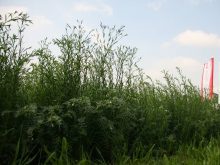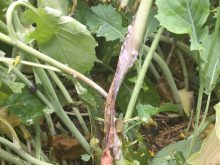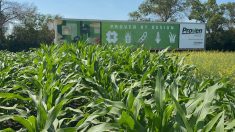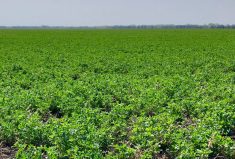Is there a need for an early-warning system for crop diseases during a dry growing season?
Generally, most farmers and agronomists agree with dry or drought conditions the risk of crop disease outbreaks is greatly reduced, if non-existent. And that is true to a large extent.
Looking at the classic crop disease triangle, the three key elements that need to exist for a disease outbreak are, first, a disease host (the crop); second, the pathogen, such as Fusarium graminearum; and, third, a favourable environment (usually some combination of moisture and temperature that encourages disease growth and spread).
If one element of the triangle is eliminated, does that eliminate the risk of the disease? For the most part, yes, but conditions can change.
While dry conditions reduce the disease risk, Rachael Melenka, client success manager with 20/20 Seed Labs in Alberta, says observations from last year showed even the occasional rain event during a dry growing season can stimulate a crop disease outbreak.

Melenka pointed to a central Alberta example in 2021. Growing conditions were quite dry and disease in the cereal crop wasn’t a concern. Then, a relatively small rainfall event stimulated a release of Fusarium graminearum spores, the disease that causes fusarium head blight (FHB) in wheat and barley. The presence of disease spores dramatically increased the disease risk.
“It was a dry growing season but even that bit of rain increased the risk,” says Melenka. “Knowing the disease spores are present helps the farmer decide if a fungicide treatment is required.”
Spornado is on the job
In that example, the presence of disease spores in the cereal crop was captured by early-warning technology known as the Spornado disease spore collection system. While Spornado was developed in Ontario more than a decade ago to monitor disease risk in potato crops, 20/20 Seed Labs has been a marketing partner of the technology in Western Canada for several years, using the technology for disease risk assessment in cereal, oilseed, potato and pulse crops.

The Spornado is a passive disease detection system that captures windborne disease spores. It is a cone-shaped collector mounted on a post or steel rod above the crop canopy facing into prevailing winds. As the wind blows in and through the Spornado cone, it deposits disease spores (and other windborne materials) on a membrane inside the Spornado cone.
That collection membrane, which is held in a cassette, can easily be removed and sent for testing at the 20/20 Seed Labs facility in Nisku, Alta., where tests will reveal whether the spores of key crop diseases are present in the field. Depending on the crop, the lab can test for FHB in wheat and barley, sclerotinia in canola (also known as white mould in dry beans) and late blight in potato crops.
Read Also

Claas brings 1000 Series SP forage harvesters to Canada
In mid-August, Claas unveiled its new line of Jaguar forage harvesters at an event in Visalia, California, deep in the heart of that state’s dairy region.
“The idea is to position the Spornado sampler in a field as the crop is maturing and ahead of the fungicide application timing,” says Melenka. In canola, for example, it’s recommended to have the Spornado in the field four to five days before the crop has reached the 20 per cent bloom stage. And, in wheat and barley, check when the heads and awns begin to emerge.
The Spornado is left exposed to prevailing winds, then every four to five days, the cassette is removed, couriered off to the lab for testing and a new cassette is inserted into the Spornado. The process is repeated perhaps three to four times just until the fungicide application window has closed. All Spornado cassettes for Western Canada are couriered off to the lab in Nisku for testing. Once the lab receives the cassette, test results are available to producers the next day.
“We guarantee a test result turnaround within 24 hours of the cassette arriving at the lab,” says Melenka. The Spornado service doesn’t provide a recommendation whether to spray or not, but alerts farmers to the fact that disease spores are present in the field. With that information, the farmer and/or crop consultant can evaluate several different factors to determine whether spraying is warranted.
Conditions can change
Ron Howard, a longtime Alberta Agriculture plant pathologist, now working as a private consultant with his own RJH Ag Research Solutions Ltd. in Brooks, Alta., agrees even in a dry year conditions can change that warrant disease prevention measures.
“Often the disease spores are present in a field and it may not take much to stir them up,” says Howard. “Even a fairly minor rain event, for example, can cause disease spread. Often there is a wind that comes with a rainstorm and if spores are low in the crop canopy, the wind can carry disease spores to other parts of the plant. Also, if the spores are airborne, the raindrops themselves can carry the spores on to the leaves and crop flowers.”
Howard also points out the favourable environment for disease spread primarily refers to the environment within the crop canopy and not the general weather of the day. It might seem like a dry, sunny day but farmers need to check the conditions within the crop canopy, he says. If there is moisture and humidity at ground level, those conditions might be conducive for disease development. “One of the old rules of thumb is if a farmer walks through his crop and his pant legs are wet, he may need to look at spraying the crop,” says Howard.

Part of a Manitoba network
Bryan Waller, Spornado sales lead based in Winnipeg, says Spornados are part of an extensive disease-monitoring program among Manitoba potato growers throughout the growing season. About 50 Spornado units are being used as part of the information collected by a network that includes Manitoba Agriculture, Food and Rural Initiatives, Keystone Potato Producers Association, Simplot and, in recent years, Weather INnovations. (Developed at the University of Guelph Ridgetown Campus, Weather INnovations specializes in providing weather-based monitoring and modelling services to agribusinesses, producer organizations, government agencies and researchers. It is now a global company currently operating weather and environmental sensory equipment at more than 1,500 locations throughout Canada, the United States and Europe.)

The Manitoba network monitors and assesses disease risk — late blight is a particular disease concern for potato crops — providing reliable information to growers and the potato industry. Waller says Spornado cassettes are tested weekly from mid-June through to October.
Melenka says Spornado technology has proven to be an effective tool in helping western Canadian farmers assess the disease risk in canola and cereal crops. Research at Farming Smarter at Lethbridge, Alta., for example, had a look at whether it made a difference where the Spornado unit is positioned in a field. “Basically we learned it will work in just about any location provided it faces into prevailing winds,” says Melenka.
Based on research conducted in Western Canada, 20/20 Seed Labs recommends one Spornado unit for each quarter section of crop, and it should be placed in an open area, away from windbreaks and buildings. It can be placed in an area of the field where crop disease has been a problem in the past, or in low-lying, wet areas that may be more prone to disease development. Try to avoid placing it on field edges or next to a gravel road where the collector could get overloaded with dust.
Meanwhile, new research at Olds College in central Alberta this year will look at a couple different aspects of how Spornado technology relates to sclerotinia detection and control in canola.
Daniel Stefner, Smart Ag project lead at Olds College, says one field-scale research project will look at how early detection of sclerotina disease spores affects the decision-making process of whether to apply a fungicide. Another research project involving field weather stations will measure how wind or air mass plays a role in disease spore collection.
“In one project, we will analyze how the early detection of disease spores collected by Spornado affects the speed, ease and final decision on whether to apply fungicide,” says Stefner. “Other sclerotina test methods such as petal test kits are done a bit later in the crop stage — so is there a greater advantage in being able to detect the disease earlier?”
The flip side of that research will look at the value of having the spore collector in the field when there is no disease present. “The crop looks good and there’s been some rainfall, which suggests favourable development of disease,” explains Stefner, “Yet the Spornado isn’t showing any signs of sclerotinia spores. If there is no disease present, is there a need to spray?”
The second part of the research project will involve positioning weather stations near the Spornado sampler and then looking at how much wind or variations in air mass movement affect the collection of disease spores. These research projects are being done in conjunction with Spornado.
There is an excellent fact sheet developed by 20/20 Seed Labs that covers installation and how to use the Spornado with photos of different crop stages indicating the recommended timing to be monitoring crops and testing the spore collection cassettes.
Each Spornado kit includes the collector as well as a couple of tests and costs about $500. For more information contact 20/20 Seed Labs at 1-877-420-2099 or visit the website at 2020seedlabs.ca. You can also learn more about Spornado by contacting Bryan Waller at 1-204-981-7772 or by visiting the Spornado website at spornadosampler.com.
















